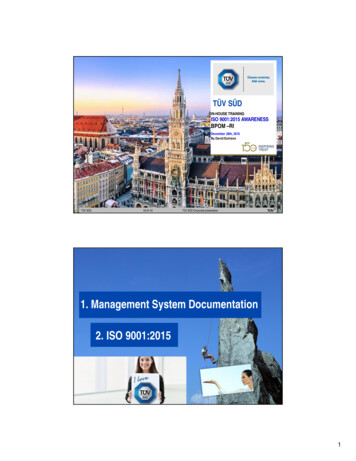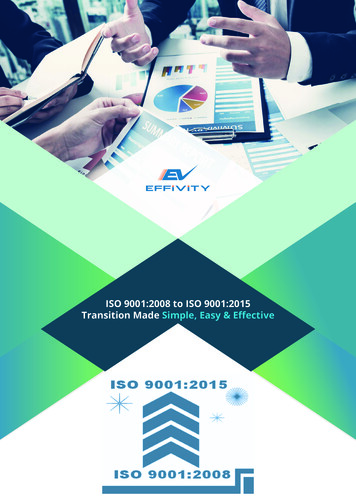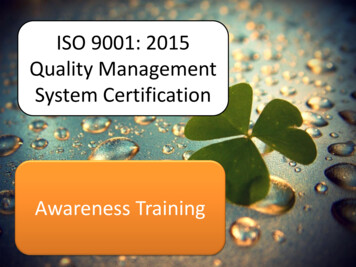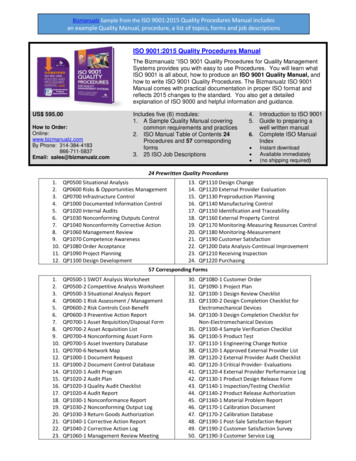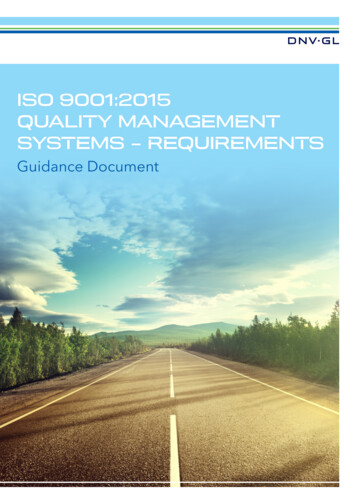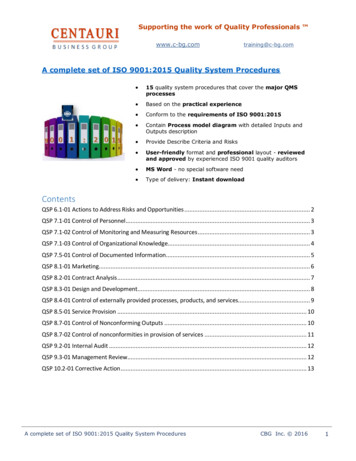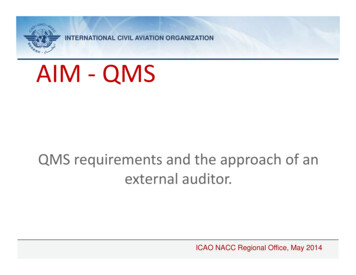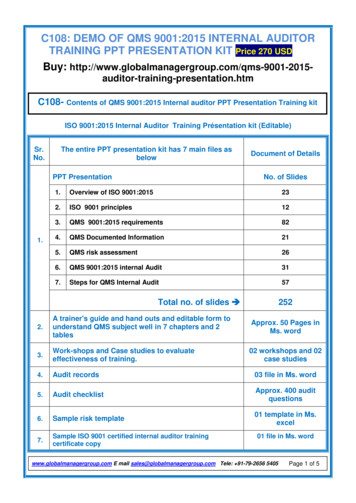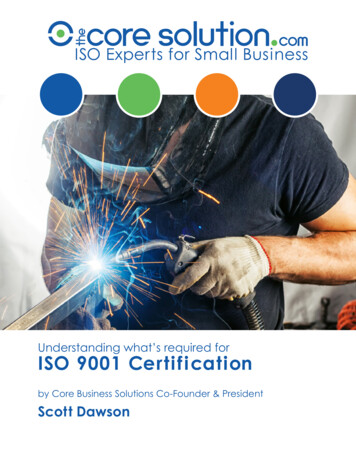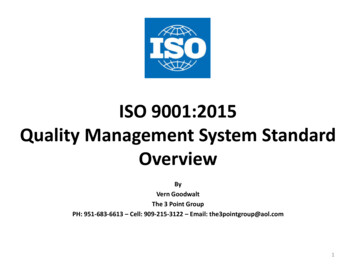
Transcription
ISO 9001:2015Quality Management System StandardOverviewByVern GoodwaltThe 3 Point GroupPH: 951-683-6613 – Cell: 909-215-3122 – Email: the3pointgroup@aol.com1
ISO 9000, the world’s most popular standardfor quality management, is now under finalreview, with an updated version ISO 9001:2015due to be available by the end of 2015.Note:Final draft available for 173 from ASQ at http://asq.org/standards-iso-9001-2015.html
ISO 9001 Implementation Timeline& Key ChangesHere are some of the important changes to beaware of: A greater emphasis on risk-based thinking More focus on achieving value for the companyand its customers Increased flexibility regarding use ofdocumentation More friendly to “service” type businesses3
ISO 9001:2015 Revision Business has changed radically since the last major revision in 2000;technology has changed how we work, geographical boundaries arealmost insignificant in today’s global economy, supply chains areincreasingly complex and the information available has multipliedexponentially. To ensure that ISO 9001 continues to serve the business community andmaintain its relevance in today’s market place, the standard is beingrevised to address the change in the business world. One thing remains constant, to be successful, businesses have to adaptto meet the growing needs of customers. ISO was originally written withthe customer in mind and that remains the priority for ISO 9001:2015.4
ISO 9000:2015Final Draft International Standard (FDIS) The Final Draft International Standard (FDIS) of ISO 9001:2015, theworld’s first quality management standard has been published. This is the final stage in the revision journey and means you can beconfident that the information contained in the FDIS will be in line withthe final version which will be published in September. Developed with today’s complex marketplace in mind, ISO 9001:2015provides an integrated approach to quality management – puttingquality at the heart of business. It’s a great time to get ahead of your competition and learn about thenew standard.5
Introduction to ISO 9000:2015 Over the years ISO has published many management system standardsfor topics ranging from quality and environment to information securityand business continuity management. In the past, despite sharing common elements, ISO management systemsstandards have all had different structures. This, in turn, results in some confusion and difficulties at theimplementation stage.6
Introduction to ISO 9001:2015(Continued) In order to understand the importance of structure in managementsystem standards, we will take a step back and look at ISO’s definition ofa management system and some of the benefits of implementing aneffective management system. ISO defines a management system as a set of procedures an organizationneeds to follow in order to meet its objectives. A management system standard provides a model to follow when settingup and operating a management system.7
A New High-Level Structure Most organizations have more than one management system standardto implement and certify. Doing this individually takes up a lot of extra time and resources, sothere is a clear need to find a way of integrating and combining thestandards in the best possible way. The management system standards to date each presents differentstructures, requirements and terminology, so integration has provedchallenging. In order to address this problem, ISO developed Annex SL – theframework for a generic management system and the blueprint for allnew and revised management system standards going forward. To address industry specific needs, additional requirements forindividual sectors will be added to this generic framework.8
How will this affect organizations? This high level structure will be rolled out across all new and revisedmanagement system standards to ensure consistency and compatibility. With Annex SL in place, management system implementers can lookforward to less conflicts, duplication, confusion and themisunderstandings that took place as a result of different managementsystem standard structures. Management system auditors will now use a core set of genericrequirements across disciplines and industry sectors.9
Transition Planning Guidance forISO 9001:201510
1. IntroductionThe main changes in the new version of ISO 9001 :2015 are; the adoption of the HLS as set out in Annex SL of ISO Directives PartOne, an explicit requirement for risk-based thinking to support and improvethe understanding and application of the process approach, fewer prescribed requirements, less emphasis on documents, improved applicability for services, a requirement to define the boundaries of the OMS, increased emphasis on organizational context, increased leadership requirements, greater emphasis on achieving desired outcomes to improve customersatisfaction.Relevant interested parties who will benefit from this guidance include; organizations using ISO 9001 :2008, accreditation bodies (ABs), certification bodies (CBs), training bodies and consultants.11
2. Transition The International Accreditation Forum (IAF) which monitorscertifications/accreditations and the ISO Committee on ConformityAssessment (CASCO) have agreed a three year transition period from thepublication date of ISO 9001 :2015. The transition period will begin in September 2015 and end inSeptember 2018.12
3. Guidance for Transition For any organization the degree of change necessary will be dependentupon the;– maturity and effectiveness of the current management system,– organizational structure and practices,– therefore an impact assessment is strongly recommended in order toidentify realistic resource and time implications.13
3. Guidance for Transition(Continued) Organizations using ISO 9001 :2008 are recommended to take thefollowing actions:– identify organizational gaps which need to be addressed to meet newrequirements,– develop an implementation plan,– provide appropriate training and awareness for all parties that have animpact on the effectiveness of the organization,– update existing quality management system (QMS) to meet therevised requirements and provide verification of effectiveness,– where applicable, work with your certification body for transitionarrangements.14
4. IAF Transition Guidance IAF has agreed an outline implementation plan (September 2015 –September 2018) to ensure a smooth migration of accreditedcertification to ISO 9001:2015 after consultation with internationalgroupings representing quality management system or auditorcertification bodies, and industry users of IS0 9001 certification services.15
Integrating ISO 9004:2009 with ISO9001:2008 to Create ISO 9001:201516
Introduction to the Clauses Organizational Context (Internal culture & external factors) The ISO Standards for Quality Management Integration– ISO 9000 Quality Management System– ISO 9001 Requirements for Products & Services– ISO 9004 Management for Sustained Success (Is much like Baldrige) Process Approach (Process linkage between clauses) Plan-Do-Check-Act Cycle (ISO 9001:2015 is PDCA focused) Risk-based Thinking (The impact of uncertainty) Compatibility with other Management System Standards (Aligning withother industry standards and approaches)17
Note:ISO 9004:2009Note:18
ISO 9004:20094 Managing for the sustained success of anorganization4.1 General4.2 Sustained success4.3 The organization's environment4.4 Interested parties, needs and expectations5 Strategy and policy5.1 General5.2 Strategy and policy formulation5.3 Strategy and policy deployment5.4 Strategy and policy communication6 Resource management6.1 General6.2 Financial resources6.3 People in the organization6.4 Suppliers and partners6.5 Infrastructure6.6 Work environment6.7 Knowledge, information and technology6.8 Natural resourcesISO 9001:20154 Context of the organization5 Leadership6 Planning for the quality management system7 Support8 Operations9 Performance evaluation10 Improvement7 Process management7.1 General7.2 Process planning and control7.3 Process responsibility and authority8 Monitoring, measurement, analysis andreview8.1 General8.2 Monitoring8.3 Measurement19
20
21
ISO 9001:2015 Cross Reference to ISO 9001:2008ISO 9001:2008ISO 9001:20151.0 Scope2.0 Normative Reference3.0 Terms and Definitions4.0 Context of the organization4.1 Understanding the organization and itscontext4.2 Understanding the needs andexpectations of interested parties4.3 Determining the scope of the quality managementsystem4.4 Quality management system and itsprocesses5.0 Leadership5.1 Leadership and commitment5.1.1 Leadership and commitment for thequality management system5.1.2 Customer focus5.2 Quality policy4.0 Context of the organization4.1 General Introduction4.1 General1.2 Application4.2.2 Quality Manual4.1General5.1 Management Commitment5.2 Customer focus5.3 Quality policy5.5.1 Responsibility and Authority5.3 Organizational roles, responsibilities and authorities5.5.2 Management Responsibility22
Cross Reference(Continued)6.0 Planning for the quality management system6.1 Actions to address risks and opportunities6.2 Quality objectives and planning to achieve them6.3 Planning of changes7.0 Support7.1 Resources and people7.1.1 General7.1.2 People7.1.3 Infrastructure7.1.4 Environment for the operation of processes7.1.5 Monitoring and measuring resources7.1.6 Organizational knowledge7.2 Competence7.3 Awareness7.4 Communication7.5 Documented information7.5.1General7.5.2 Creating and updating7.5.3 Control of documented Information5.4.2 Quality Management System Planning8.5.3 Preventive Action5.4.l Quality Objectives5.4.2 Quality Management System Planing6.1 Provision of Resources6.3 Infrastructure6.4 Work Environment7.6 Control of Monitoring and Measuring EquipmentNew6.2.1 General6.2.2 Competence, Training and Awareness6.2.2 Competence1 Training and Awareness5.5.3 Internal Communication4.2.1 General4.2.3 Control of Documents4.2.4 Control of Records23
Cross Reference(Continued)8.0 Operations8.l Operational planning and control8.2 Determination of requirements forproducts and services7.1 Planning of Product Realization7.2.1Determination of requirements related to theproduct8.2. Customer communication7.2.3 Customer Communication8.2.2 Review of requirements related to theproducts and services7.2.2 Review of requirements related to theproduct8.2.3 Review of customer requirements7.2.2 Review of requirements related to the product8.3 Design and development of products and services8.3.l General8.3.2 Design and development planning8.3.3 Design and development Inputs8.3.4 Design and development controls7.3.1 Design and Development Planning8.3.5 Design and development outputs8.3.6 Design and development changes7.3.2 Design and Development Inputs7.3.4 Design and Development Review7.3.5 Design and Development Verification7.3.6 Design and Development Validation7.3.3 Design and Development Outputs7.3.7 Design and Development Changes24
Cross Reference(Continued)8.4 Control of externally provided products and services8.4.1 General8.4.2 Type and extent of control of external provision8.4.3 Information for external providers8.5 Production and service provision8.5.l Control of production and :service provision8.5.2 Identification and traceability8.5.3 Property belonging to customers or externalproviders8.5.4 Preservation8.5.5 Post-delivery activities8.5.6 Control of changes8.6 Release of products and services8.7 Control of nonconforming process outputs, productsand services7.4.l Purchasing Process7.4.1 Purchasing Process7.4.2 Purchasing Information7.5.1 Control of Production and Service Provision7.5.3 Identification and Traceability7.5.4 Customer Property7.5.5 Preservation of Product7.5.1 Control of Production and Service ProvisionNew7.4.3 Verification of Purchased Product8.3 Control of Nonconforming Product25
Cross Reference(Continued)9.0 Performance Evaluation9.1 Monitoring, measurement, analysis andevaluation9.1.1 General9.l.2 Customer satisfaction9.1.3 Analysis and evaluation9.2 Internal audit9.3 Management review10.0 Improvement10.1 General10.2 Nonconformity and corrective action10.3 Continual improvement8.1 General8.1General8.2.1Customer Satisfaction8.4 Analysis of Data8.2.2 Internal Audit5.6 Management Review8.5.1 Continual Improvement8.5.2 Corrective Action8.5.1 Continual Improvement26
The 10 Clauses of ISO 9001:201527
The Ten Clauses Clause 1: Scope Clause 2: Normative references Clause 3: Terms and definitions ( any new terms) Clause 4: Context of the organization Clause 5: Leadership Clause 6: Planning Clause 7: Support Clause 8: Operation Clause 9: Performance evaluation Clause 10: Improvement28
Clause 1: Scope Clause 1: Scope– The scope sets out the intended outcomes of the managementsystem. The outcomes are industry specific and should be aligned withthe context of the organization (clause 4).29
Clause 2: Normative Clause 2:– Normative references Provides details of the reference standards orpublications relevant to the particular standard.30
Clause 3: Terms & Definitions Clause 3:– Terms & Definitions details terms and definition applicable to thespecific standard in addition to any formal related terms anddefinitions standard.31
Clause 4: Context of the Organization Clause 4 consists of four sub-clauses:– 4.1 Understanding the organization and its context– 4.2 Understanding the needs and expectations of interested parties– 4.3 Determining the scope of the management system– 4.4 The management systemAs the flagstone of a management system, clause 4 determines why theorganization is here.As part of the answer to this question, the organization needs to identifyinternal and external issues that can impact on its intended outcomes, aswell as all interested parties and their requirements.It also needs to document its scope and set the boundaries of themanagement system – all in line with the business objectives32
Clause 5: Leadership Clause 5 comprises three sub-clauses:– 5.1 Leadership and commitment– 5.2 Policy– 5.3 Organizational roles, responsibilities and authoritiesThe new high level structure places particular emphasis on leadership,not just management as set out in previous standards.This means top management now has greater accountability andinvolvement in the organization’s management system.They need to integrate the requirements of the management system intothe organization’s core business process, ensure the management systemachieves its intended outcomes and allocate the necessary resources.Top management is also responsible for communicating the importanceof the management system and heighten employee awareness andinvolvement33
Clause 6: Planning Clause 6 includes two sub-clauses:– 6.1 Actions to address risks and opportunities– 6.2 Management system objectives and planning to achieve themClause 6 brings risk-based thinking to the front. Once the organizationhas highlighted risks and opportunities in clause 4, it needs to stipulatehow these will be addressed through planning.The planning phase looks at what, who, how and when these risks mustbe addressed. This proactive approach replaces preventative action andreduces the need for corrective actions later on.Particular focus is also placed on the objectives of the managementsystem. These should be measurable, monitored, communicated, alignedto the policy of the management system and updated when needed.34
Clause 7: Support Clause 7 consists of five sub-clauses:– 7.1 Resources– 7.2 Competence– 7.3 Awareness 7.4 Communication– 7.5 Documented informationAfter addressing the context, commitment and planning, organizationswill have to look at the support needed to meet their goals andobjectives.This includes resources, targeted internal and external communications,as well as documented information that replaces previously used termssuch as documents, documentation and records.35
Clause 8: Operation Clause 8 has one sub-clause:– 8.1 Operational planning and controlThe bulk of the management system requirements lies within this singleclause.Clause 8 addresses both in-house and outsourced processes, while theoverall process management includes adequate criteria to control theseprocesses, as well as ways to manage planned and unintended change.36
Clause 9: Performance Evaluation Clause 9 is formed of three sub-clauses:– 9.1 Monitoring, measurement, analysis and evaluation– 9.2 Internal audit– 9.3 Management reviewHere organizations need to determine what, how and when things are tobe monitored, measured, analyzed and evaluated.An internal audit is also part of this process to ensure the managementsystem conforms to the requirements of the organization as well as thestandard, and is successfully implemented and maintained.The final step, management review, looks at whether the managementsystem is suitable, adequate and effective.37
Clause 10: Improvement With two sub-clauses in place, Clause 10 looks at how non-conformitiesand corrective actions should be managed:– 10.1 Non-conformity and corrective action– 10.2 Continual improvementIn an ever-changing business world, not everything always goesaccording to plan. Clause 10 looks at ways to address non-conformitiesand corrective action, as well as strategies for improvement on acontinual basis38
Additional Benefits of UsingManagement System Standards.
Benefits of the New Standard Bringing Quality and Continuous Improvement into the heart of yourbusinessThe revised standard will ensure that quality management is nowcompletely integrated and aligned with the business strategies of yourorganization. LeadershipGreater involvement in the management system by the leadership teamwill ensure the whole organization will be motivated towards theorganizations goals and objectives. Introduction of Risk & Opportunity ManagementReinforces use of the management system as a governance tool and willhelp identify business opportunities that contribute to bottom lineimprovements. An Integrated ApproachWith the new structure applicable to all new ISO management systemsstandards it well be much easier to implement multiple, integratedmanagement systems.40
The New ISO 9001: 2015 Structure The new standard expected in September 2015, will be based on AnnexSL – the new high level structure (HLS) that brings a common frameworkto all management system standards. This helps to keep consistency,alignment different management system standards, offer matching subclauses against the top-level structure and apply common languageacross all standards.The key changes in the standard are:–––––The emphasis on leadershipThe focus on risk managementEmphasis on objectives measurement and changeCommunication and awarenessFewer prescriptive requirements With the new standard in place, organizations will find it easier toincorporate their quality management system into the core businessprocesses and gain greater business benefit.41
Other Benefits Improved Business Performance– Using standards ensures all business processes are integrated and aligned withthe business strategies of the organization.– Used as a business management tool, this will improve performance, removecomplexity, drive real value and embed continual improvement. Improved Risk and Opportunity Management– The requirements to identify risks and opportunities affecting an organizationensures they are managed more effectively thereby improving operationalefficiency, reducing duplication, saving both time and money. Enhanced Reputation– Adopting a standard sends a clear message to existing and prospectivecustomers that the organization is taking a leading, innovative and proactiveapproach to managing the business.42
Other Benefits(Continued) Increased Efficiency– By providing a robust framework and focus, standards can increaseoperational efficiency, reducing expensive mistakes thereby saving time andmoney. Increased Engagement– By adopting a management system, an organization can ensure all employeesare working to common goals driven from the business strategy Improved Integration– The new common structure for all management system standards will ensurethat integration of more than one system will be smoother, without investing alot of extra time and money.43
Discussion44
References http://www.iso.org– ISO 9000:2008– ISO 9000:2015 (07-10-14 draft) http://www.bsigroup.com http://www.dnvgl.com http://www.saiglobal.com45
ISO 9000:2015 Final Draft International Standard (FDIS) The Final Draft International Standard (FDIS) of ISO 9001:2015, the world's first quality management standard has been published. This is the final stage in the revision journey and means you can be confident that the information contained in the FDIS will be in line with


